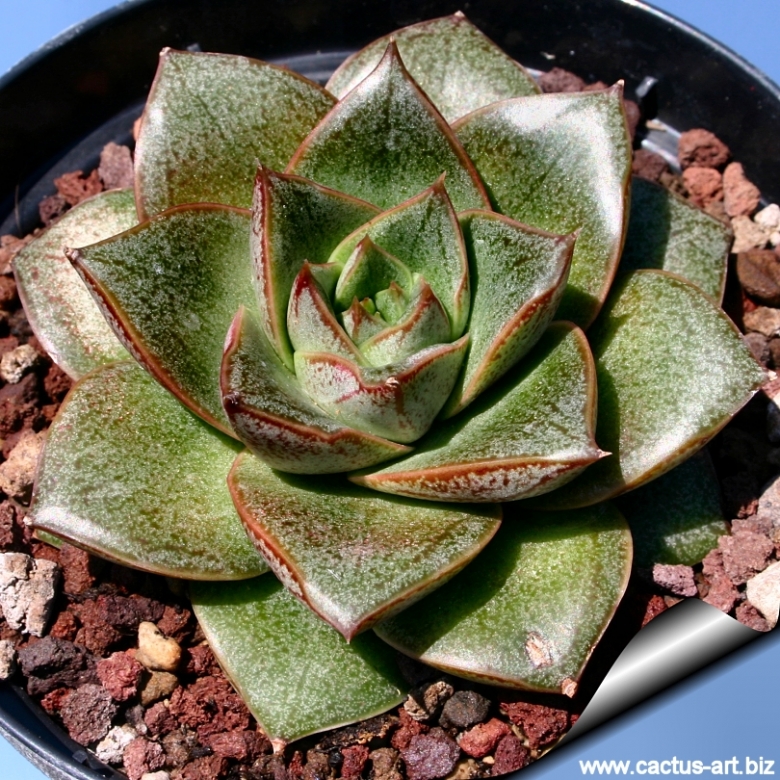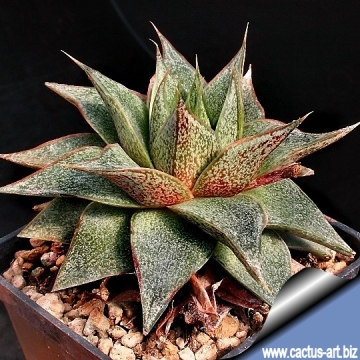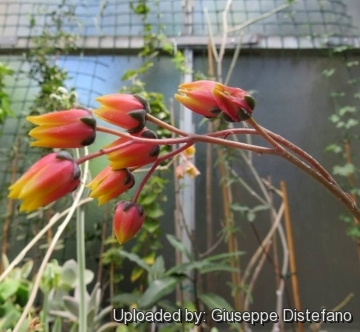
Echeveria purpusorum Photo by: Cactus Art
It is one of the slowest-growing Echeverias and it is necessary to cultivate it for many years to get a nice specimen. Its attractiveness lies in the beautifully speckled leaves.
Origin and Habitat: Southern Mexico, Puebla and Oaxaca (Type locality Puebla: near San Luis Atolotitlan)
Habitat: Grows in quite hot and dry areas.
Synonyms:
Description: Echeveria purpusorumSN|21880]]SN|21880]] is a small slow growing and unusual species. This also is a plant usually known as an Urbinia. It has glabrous, stem-less, succulent rosettes, up to 6-8 cm in diameter and tall, it stay usually solitary but it can offset to form a dense clump. Its attractiveness lies in the beautifully speckled leaves; the ground colour of the leaves is a deep olive-green with grey-green or white-green spots and mottled with irregular markings of reddish-brown. A neat and charming little succulent.
Derivation of specific name: Named for C. A. and J. A. Purpus of Germany.
Stem: Very short (almost stemless) it can slowly grow up to 5-7 cm tall, and approx 2 cm in diameter.
Rosette: Usually solitary, regular, with about 8-12 crowded leaves.
Leaves: Short, and turgid, broadly ovate or triangular-ovate, tapering to a sharply pointed tip, somewhat recurved at tips, 3-4 cm long and 1,5-2,5(-3) cm wide at the base, 1 cm thick, flat above, convex beneath, obscurely keeled on the back surface, deep olive-green, spinach-green to brown, punctuate grey-green or white-green and mottled with irregular small reddish-brown spots. Margins sharp, translucent, not mottled dark purple. The epidermis is unusually thick with opaque epidermal cell and with few stomata in both leaf surfaces.
Inflorescence: Scape about 20-30 cm tall, simple with racemes (cincinni)of 6-9 flowers , bearing in its basal portion few ovate and acute bracts up to 15 mm long of the same colour of leaves.
Flowers: Buds are red-orange and open to yellow. Pedicel up to 12 mm long. Sepals 2-3 mm, pointed, adpressed to petals. Calyx globose-urceolate, fused near base, thick, 10-12 mm long, greatest diameter 9 mm, about 4 mm in diameter at mouth at anthesis; pink below, dark-orange to scarlet above, yellow at the tips. The petals are thick, deeply hollowed within at base, but scarcely keeled; nectaries large and thick, truncate-reniform, 2 mm. wide. Style apple-green, stigmas rays-maroon.
Blooming season: Late spring (May-June).
Notes: The plants that are found in cultivation are quite uniform, probably owing to vegetative propagation from a single original import. Any evident departures from the standard form, may be suspected to be due to garden hybridization, whether accidental or intentional. Numerous hybrids are now in cultivation.
Bibliography: Major references and further lectures
1) Eric Walther “Echeveria” California Academy of Sciences, 01 January 1972
2) Eggli, Urs “Illustrated Handbook of Succulent Plants, Crassulaceae Illustrated Handbook of Succulent Plants.” Springer, Berlin 2002
3) Hermann Jacobsen “A Handbook of Succulent Plants: Descriptions, Synonyms, and Cultural Details for Succulents Other Than Cactaceae”, Volume 1 Blandford Press, 1960
4) Hermann Jacobsen “Abromeitiella to Euphorbia” Blandford Press, 1960
5) John Robert Brown “Unusual Plants: 110 Spectacular Photographs of Succulents” Abbey Garden Press, 1954
6) Carruthers & Ginns, “Echeverias: A guide to cultivation & identification”, pl. 17 1973.
7) Graf, “Exotica”, series 4, edn 12, 1: 898 1985.
8) Pilbeam, “The genus Echeveria” 225, 226 2008.
9) James Cullen “The European Garden Flora Flowering Plants: A Manual for the Identification of Plants Cultivated in Europe, Both Out-of-Doors and Under Glass” Cambridge University Press, 11 August 2011
 A long leafed form (hybrid?) Photo by: Valentino Vallicelli
A long leafed form (hybrid?) Photo by: Valentino Vallicelli Echeveria purpusorum Photo by: Valentino Vallicelli
Echeveria purpusorum Photo by: Valentino Vallicelli Echeveria purpusorum Photo by: Cactus Art
Echeveria purpusorum Photo by: Cactus Art Echeveria purpusorum Photo by: Cactus Art
Echeveria purpusorum Photo by: Cactus Art Echeveria purpusorum Photo by: Giuseppe Distefano
Echeveria purpusorum Photo by: Giuseppe DistefanoSend a photo of this plant.The gallery now contains thousands of pictures, however it is possible to do even more. We are, of course, seeking photos of species not yet shown in the gallery but not only that, we are also looking for better pictures than those already present.
Read More... Cultivation and Propagation: Echeveria purpusorumSN|21880]]SN|21880]] is a summer-growing and relatively easy plant. It makes great potted specimens and is a succulent for beginning collectors.
Soil: Use a very porous soil, which will allow quick drainage.
Repotting: If potted, repot them preferably in the spring, if their roots become cramped. Generally, they should be repotted every other year in order to provide fresh soil. However, this doesn't necessarily mean they'll need larger containers. Fill about a quarter of the pot with broken crocks, gravel, etc. to promote good drainage. After repotting, do not water for a week or more. Use pot with good drainage. Eventually, as the plant becomes mature grow it slowly, and adopt a new repotting period, using intervals of every 2 - 3 years. Additionally grow it under drier conditions or with stronger sunlight.
Fertilization: Slow release fertilisers with a low to moderate nitrogen content are adequate for the spring and summer growing seasons, and additional fertiliser applications would not required until spring.
Exposure: It can tolerate sun to shade but - generally speaking - the more light a plant gets the better it will display its colours and shape. However, when moving plants from lower light conditions into full sun, be wary of sun scorch, most easily avoided by ensuring plants are well-watered before moving them on a cloudy day.
Watering: They can tolerate extended dry periods and survive drought without the need for watering, but they will grow stronger if they receive adequate moisture during their growing season, amd never allowing the plant to remain waterlogged (root rot sensitive).
Ventilation: Good air movement is important for minimising pest and disease risks, and avoiding excessive humidity in cool winter conditions is important to successfully growing Echeveria in the nursery environment.
Hardiness: It can tolerate light frosts, but it is best overwintered at 5-10 °C.
With the cooler autumn temperatures tending to make their foliage colours become more intense than those of the active summer growing season.
Pest & disease: Aphids like this plant (and all flowering Echeveria).
Propagation: Usually by seeds, but If the plant is repotted some of the bottom leaves can be removed, in order to attempt leaf propagation, it is also a common practice to collect the leaves on the flower stem. However this is not one of the easiest species to root, as many such cuttings will dry out without producing a plantlet, but with perseverance it is likely to get a few new plants.















